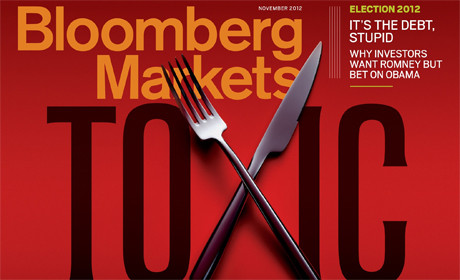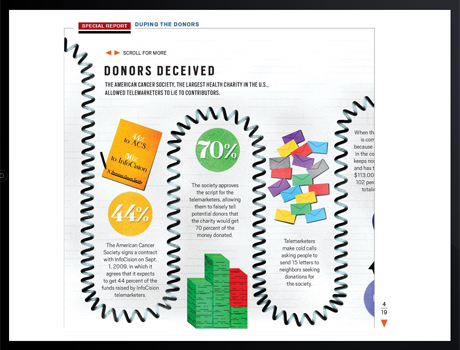
Monthly print title Bloomberg Markets is distributed to the world's richest people in the world. The title, which "covers the people, stories and ideas that move financial markets" is sent out to the 310,000 people who pay around $20,000-a-year as a subscriber to the Bloomberg Professional service, or Bloomberg Terminal.
More than 90 per cent of the magazine's circulation goes to subscribers of the terminal, who are also sent the recently-launched luxury lifestyle magazine Bloomberg Pursuits.
Getting the eyeballs of the "financial global elite" is a sweet spot for selling advertising, which in turn funds in-depth investigative journalism carried out by the Bloomberg Markets journalists.
And by linking up with the Bloomberg Terminal, which shows real-time financial market data movements, the readers of both titles get a truly multiplatform experience with codes included in the print and iPad editions of the magazine that enable users to access additional information from the terminal.
- Bloomberg Terminal: Not just for traders
The terminal, which was providing a LinkedIn-like service to its clients pre-internet, shows other members who are online. A green dot by a name signifies someone is online using a desktop computer; a blue dot shows they are using the terminal iPad or Blackberry app.
In addition to showing markets data, the terminal has instant messaging, it can be used to search for jobs, and it is an online market place where the financial elite buy and sell their yachts and planes.
- Bloomberg Markets in print
"Investigative journalism has always been a big part of the Markets magazine heritage," Michael Dukmejian, publisher, Bloomberg Markets and Bloomberg Pursuits, told Journalism.co.uk.
"We've broken a number of major stories over the years that have impacted financial markets, companies, individuals. That's a very big part of what we do. We get a lot of press pick up, a lot of attention and laws are changed as a result."
According to Bloomberg, circulation of Bloomberg Markets is at 375,000, with 310,000 of those going to Bloomberg Professional service subscribers, 60 per cent of whom are outside the US, 124,000 in EMEA and 175,000 in Asia.
And the magazine's publisher also ensures engagement. "Bloomberg Markets comes with a subscription to the Bloomberg Professional service or terminal. If a person doesn't use the subscription for 60 days they drop off the magazine distribution," Dukmejian explained.
And with a 92 per cent duplication between readers and terminal users, there is space for creative cross-promotion and referencing. "There's inherent interaction with digital," Benson said.
Dukmejian added: "There is no other magazine where other subscribers have one another's email address."
- The app

The app is rich with interactives, linking to the sources and evidence used in the editorial. For example, the investigation into telemarketing allows app users to hear phone calls and see the signed contracts between the charities and the telemarketers.
"With the app we have become a cable channel," Benson said. "We are beyond a magazine as we provide sound, motion and evidence such as the contracts."
Dukmejian added: "What the iPad allows us to do with these stories is actually communicate some of the interesting things that have gone into building that story. For example, in the telemarketers story we were able to record the audio of the phone conversations these telemarketers were having with individuals and ostensibly stretching the truth as to what was going to happen with their contributions.
"In the same way we were able to look at the contracts between the telemarketer and these charities and actually showed in there that they had agreed to the substantial percentages of the dollars going to the telemarketers.
"So I think what the iPad does is allow all the background information and materials that are collected in a major investigative story to be highlighted through the app in a way they can't be in a magazine."
- Global Pursuits
Four editions are scheduled for next year, and an iPad edition is planned for launch.
Dukmejian said: "We had very good reaction from our readers to the 'wealth' section, but we couldn't do enough justice to it in the magazine, because the magazine itself has a different purpose, so we thought about the notion of a lifestyle magazine called Pursuits that went to the exact same readership and audience.
"So we came up with the idea of a global, luxury lifestyle magazine that goes to the richest men in the world."
Free daily newsletter
If you like our news and feature articles, you can sign up to receive our free daily (Mon-Fri) email newsletter (mobile friendly).
Related articles
- Bloomberg Media and Puck's subscription strategy: 'wake up the sleepers and prioritise the keepers'
- From Reuters to The New York Times, Big Oil pays 'most trusted media brands' to push greenwashing
- Newsrewired special: Angie Lau, founder of Forkast.News, on developing a business mindset
- Subscription strategy lessons from The Atlantic, Bloomberg and Business Insider
- Bloomberg Media invests in climate reporting, launches new brand









